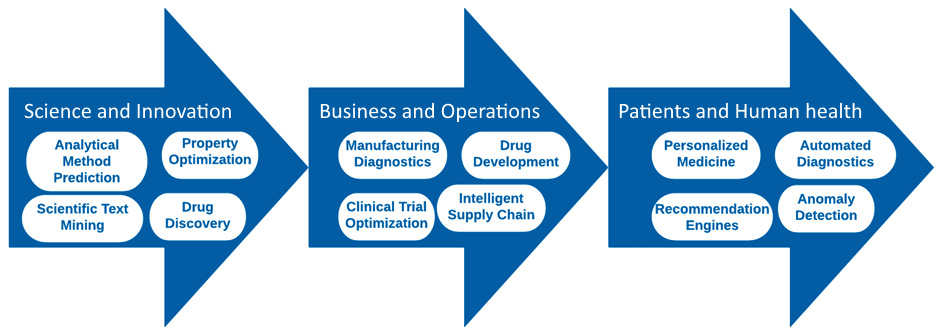Combining biotechnology and machine learning
In recent years, scientific advancements in the field, boosted by applications of machine learning and various predictive technologies, have led to many major accomplishments, such as the discovery of new and novel treatments, faster and more accurate diagnostic tests, greener manufacturing methods, and much more. There are countless areas where machine learning can be applied within the biotechnology sector; however, they can be narrowed down to three general categories:
- Science and Innovation: All things related to the research and development of products.
- Business and Operations: All things related to processes that bring products to market.
- Patients and Human Health: All things related to patient health and consumers.
These three categories are essentially a product pipeline that begins with scientific innovation, where products are brainstormed, followed by business and operations, where the product is manufactured, packaged, and marketed, and finally the patients and consumers that utilize the products. Throughout this book, we will touch on numerous applications of machine learning as they relate to these three fields within the various tutorials that will be presented. Let's take a look at a few examples of applications of machine learning as they relate to these areas:

Figure 1.3 – The development of a product highlighting areas where AI can be applied
Throughout the life cycle of a given product or therapy, there are numerous areas where machine learning can be applied – the only limitation is the existence of data to support the development of a new model. Within the scope of science and innovation, there have been significant advances when it comes to predicting molecular properties, generating molecular structures to suit specific therapeutic targets, and even sequencing genes for advanced diagnostics. In each of these examples, AI has been – and continues to be – useful in aiding and accelerating the research and development of new and novel products. Within the scope of business and operations, there are many examples of AI being used to improve processes such as intelligently manufacturing materials to reduce waste, natural language processing to extract insights from scientific literature, or even demand forecasting to improve supply chain processes. In each of these examples, AI has been crucial in reducing costs and increasing efficiency. Finally, when it comes to patients and health, AI has proven to be pivotal when it comes to recruiting people for and shaping clinical trials, developing recommendation engines designed to avoid drug interactions, or even faster diagnoses, given a patient's symptoms. In each of these applications, data was obtained, used to generate a model, and then validated.
The applications of AI we have observed thus far are only a few examples of the areas where powerful predictive models can be applied. In almost every process throughout the cycle where data is available, a model can be prepared in some way, shape, or form. As we begin to explore the development of many of these models in various areas throughout this process, we will need a few software-based tools to help us.



